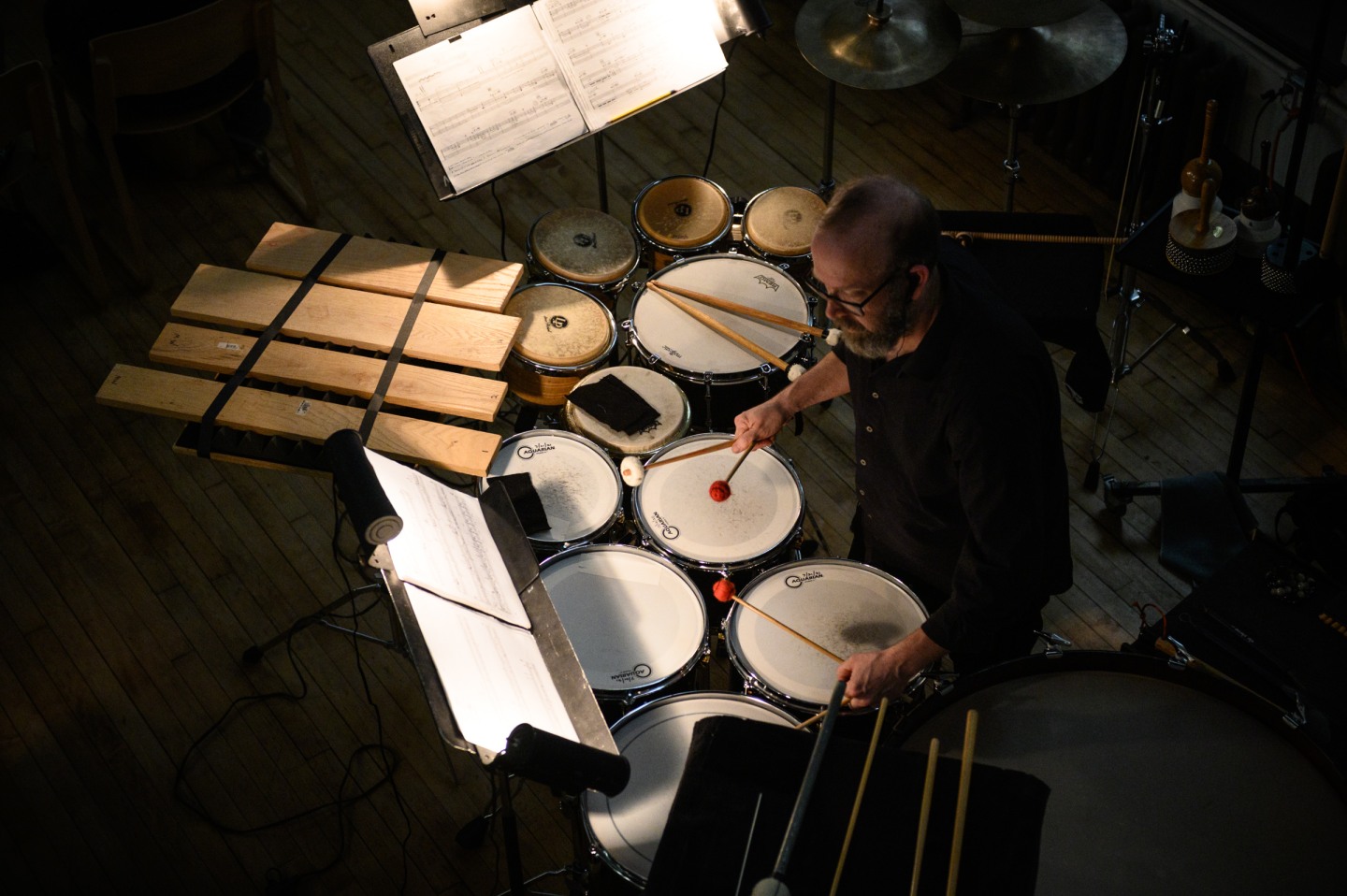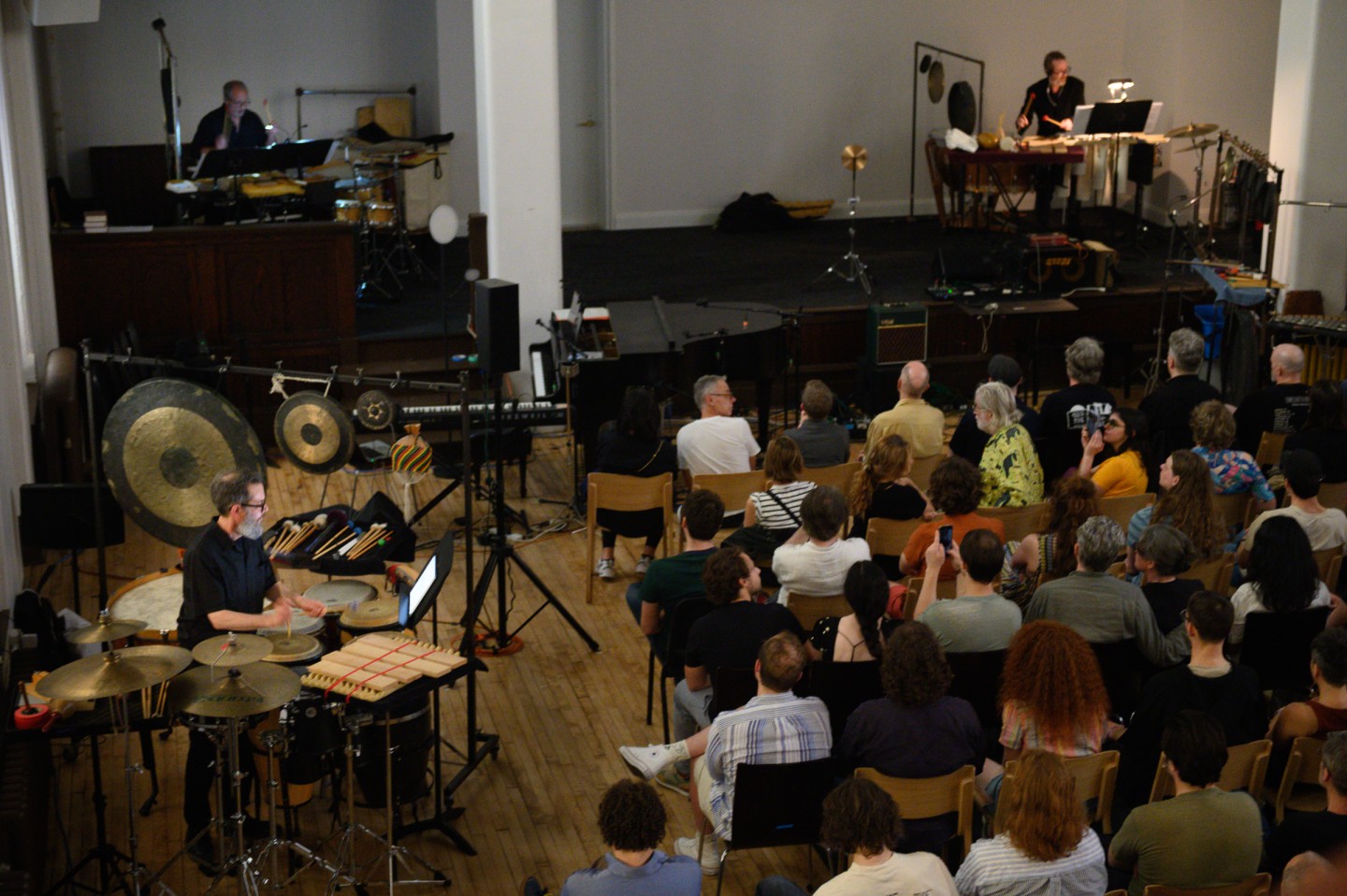Star remnants inspired this percussion masterpiece

Table of Contents
French composer Gérard Grisey’s Le Noir de l’Etoile is a portal to deep space and an awe-inspiring live experience.

Jack Beal for Bang on a Can
“Apollo Frequencies” is a new series that explores music that seems to come from another world. The first edition deals with French composer Gérard Grisey’s sounds from deep space.
In May 1969, two months before Neil Armstrong and Buzz Aldrin landed on the moon, the Apollo 10 mission entered the moon’s orbit. As the ship’s path crossed the dark side of the moon — supposedly the only place in our solar system that the Earth’s radio waves can’t reach — its crew heard otherworldly sounds.
“You hear that? That whistling sound?” Eugene Cernan can be heard asking from the lunar module in footage released to the public by NASA in 2016. “Yes,” John Young responds from the command module. “Sounds like — you know, outer-space-type music.” Maybe, the astronauts considered, these were transmissions from an intelligent race somewhere in the cosmos.
Video of the Apollo 10 crew hearing this “alien music” went viral upon its release. In an episode of the Science Channel’s NASA’s Unexplained Files, Apollo 15 command module pilot Al Worden and planetary scientist Kevin Grazier emphasize the uncertainty of the noises. But the phenomenon had already been demystified by scientists. The sounds were not of this Earth, but their origins were mundane: They were simply beat frequencies, the result of two radio signals interfering with each other — in this case, that of the lunar module and that of the command module.
I prefer the mysterious version, the one that allows us to suspend our disbelief and marvel at things outside our realm of understanding. In my new column, “Apollo Frequencies,” I’ll explore extraordinary sounds, ambitious music that challenges what we previously thought possible.

Talujon percussion ensemble performing Gérard Grisey’s Le Noir de l’Etoile.
Jack Beal for Bang on a Can
Eighteen months before the Apollo 10 crew heard music on the dark side of the moon, a 24-year-old Cambridge astronomy PhD student named Jocelyn Bell heard a beat from space. Through a 120-mile radio telescope she’d built in a four-acre field, she noticed a tiny but significant squiggle in her readings, caused by impulses arriving 1.3 seconds apart. After ruling out man-made interference, Bell and her supervisors set out to discover the source of the signal. Like the apparent Apollo 10 anomaly, the news went viral (in 1960s terms), with armchair astronomers claiming Bell’s findings amounted to definitive evidence of extraterrestrial life. But Bell found a second such space beat a month later, suggesting that the findings were naturally occurring, not the scribblings of an alien race.
Bell had discovered pulsars, the detritus of exploding stars. Their matter is compressed so tightly that their atoms are crushed to form dense clusters of neutrons while their charged particles are relegated to their magnetic fields. A pulsar with a radius of 15 kilometers would have a mass as great as our sun. A pulsar the size of a thimble would weigh 100 billion metric tons on Earth. When a pulsar spins, a beam of light formed by its charged particles extends on an axis across its enormous magnetic field, roughly one trillion times larger than our planet’s. Thus, this beam, sent from lightyears away, sweeps the Earth upon each rotation, like the emissions of a deep-space lighthouse.
In the years following Bell’s revelation, pulsars became a pop-culture phenomenon as well as a scientific one. Her supervisors won the 1974 Nobel prize in physics — as a woman, Bell was snubbed — and an illustration of her radio telescope readings appears on the cover of Joy Division’s Unknown Pleasures (and, therefore, the t-shirts of a thousand hipsters).

Jack Beal for Bang on a Can
In the late ’80s, inspired by a meeting with cosmologist John Silk, French composer Gérard Grisey became fascinated with pulsars. A pioneering member of a movement called spectralism, Grisey’s primary interest was in transforming the timbral qualities of sounds by manipulating their acoustic properties (spectra), which can be represented visually on a spectrogram. But by 1989, when he started writing Le Noir de l’Etoile (The Black of the Star), he’d moved past the form’s strictures into less chartable territory. The piece was first performed by the Percussions de Strasbourg in 1991.
“I was seduced by those of the Vela pulsar, and I immediately asked myself, like Picasso picking up an old bicycle seat, ‘What could I do with it?’” Grisey once said of his path to Le Noir de l’Etoile. “The answer came slowly: Integrate them into a musical work without manipulating them; allow them simply to exist, like landmarks at the heart of a piece of music… and finally to use their frequencies as tempi and to develop the ideas of rotation, periodicity, slowing, and acceleration, and of ‘glitches,’ which the study of pulsars suggests to astronomers.” Percussion, he explained, was the ideal medium for this project because, “like pulsars, it is primordial and implacable, and, like them, delineates and measures time.”
On the afternoon of May 3, I watched the Talujon percussion ensemble — an avant-garde group of contemporary classical scene veterans — perform Le Noir de l’Etoile in full at the Church of St. Luke & St. Matthew in Brooklyn as part of Bang on a Can’s Long Play festival. The audience sat in rows of wooden chairs in front of the stage, its six percussionists surrounding us. Each had an elaborate setup distinct from the others — from gongs and bass drums to congas and kits to small cymbals and chimes. The array notably excluded keyboards, as Grisey felt the piece would be best with only “skins and metals” involved.
A disembodied voice introduced the piece and its main characters, the pulsars Vela and 0329+54 (the latter named for its galactic coordinates), and the performance began in earnest. It started softly, a barely struck bass drum rustling the air of the silent room. The other percussionists entered slowly, but the pace soon picked up, introducing the composition’s central motif; as the piece’s proverbial pulsar turned, the percussionists played cascading rhythms in clockwise sequence, representing the celestial body’s sweeping beam.
The effect was, at first, totally disorienting. Trying to locate the source of each noise would require spinning 360 degrees, which, seated as we were, was impossible. But when I closed my eyes, the spinning sound became transportative, a portal to the fractured darkness of deep space.
More than 30 years old now, Le Noir de l’Etoile is not Grisey’s most famous or formally inventive work, but it is an awe-inspiring experience. There are very few pieces of art that successfully emulate nature, let alone the nature of the universe. But as the sun beat down on the Church of St. Luke and St. Matthew on Saturday, Le Noir de l’Etoile got close.
If you liked the article, do not forget to share it with your friends. Follow us on Google News too, click on the star and choose us from your favorites.
If you want to read more Like this articles, you can visit our Social Media category.